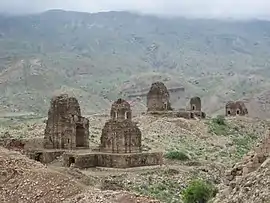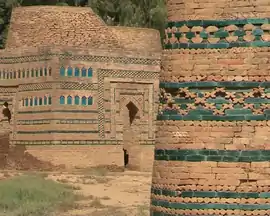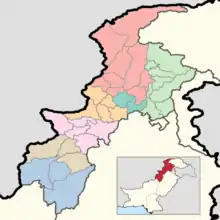Dera Ismail Khan District
Dera Ismail Khan District (Pashto: ډېره اسماعیل خان ولسوالي, Urdu: ضلع ڈیره اسماعیل خان, Saraiki: ضلع ڈېره اسماعیل خان ; often abbreviated as D.I. Khan) is a district in Dera Ismail Khan Division of Khyber Pakhtunkhwa province in Pakistan. The capital of the district is the town of Dera Ismail Khan. The district has an area of 9,334 km2 (3,604 sq mi) and a population of 1,627,132 as of the 2017 Census.[2]
Dera Ismail Khan District
ضلع ڈیره اسماعیل خان | |
|---|---|
  Clockwise from top: DI Khan is home to the millennium-old Hindu-Buddhist ruins at Kafir Kot, The Lal Marah Tombs. | |
 Map of Dera Ismail Khan | |
| Country | |
| Province | |
| Founded by | Sardar Ismail Baloch |
| Headquarters | Dera Ismail Khan |
| Government | |
| • District Nazim | Azizullah Alizai (PTI) |
| • District Naib Nazim | Ismail Baloch from Paroa |
| Area | |
| • Total | 9,334 km2 (3,604 sq mi) |
| Population (2017)[1] | |
| • Total | 1,695,688 |
| • Density | 180/km2 (470/sq mi) |
| Time zone | UTC+5 (PST) |
| Main language(s) | Saraiki, Pashto |
Geography
The district of Dera Ismail Khan is bounded on the east by the Bhakkar and Dera Ghazi Khan districts of Punjab. Eastern portions of the district along the Indus River are characterized by fertile alluvial plains, while lands farther from the river consist of clay soil cut by ravines from rainfall. The district is bounded on the southwest by a thin strip of the South Waziristan district, formerly of the Federally Administered Tribal Areas, which separates D.I Khan from the Takht-e-Sulaiman Mountain in the neighboring Baluchistan province. In the northwest is the Tank District.[3]
D.I Khan is separated from the Marwat plains of the Lakki Marwat district by a spur of clay and sandstone hills that stretch east from the Sulaiman Mountains to the Indus River known as the Sheikh Badin Hills. The highest peak in the range is the limestone Sheik Badin Mountain, which is protected by the Sheikh Badin National Park. Near the Indus River is a spur of limestone hills known as the Kafir Kot hills, where the ancient Hindu complex of Kafir Kot is located.[3] DI Khan is also considered the center of Pakistan because of its location between Bhakkar of South Punjab, Mianwali of North Punjab, Zhob of Balochistan and South Waziristan of Pakistan tribal belt.
Education
The Dera Ismail Khan district has many schools and colleges, predominantly in the capital of Dera Ismail Khan.
- University of Agriculture, Dera Ismail Khan
- Gomal University- Two campuses in Dera Ismail Khan
- St. Helen's High School & College
- Qurtuba University
- Gomal Medical College
- University Wensam College
- Punjab College Meraj Campus
- Dar-e-Arqam School Dera Ismail Khan
- The City School Dera Ismail Khan
- Government College of Technology, Dera Ismail Khan campus
- Beaconhouse School System
- Overseas Pakistan Foundation School
- Educare School
- Knowledge Home
- LEEDS School & College
History
The Dera Ismail Khan District is littered with ruins from ancient civilizations. Dera Ismail Khan is home to the collection of Hindu ruins from two separate sites 20 miles apart,[3] jointly known as Kafir Kot.
The region came under the influence of the Nanda Empire of ancient India from 300 BCE. With the rise of Chandragupta Maurya, the region came under the complete control of the Mauryan Empire. Afterward, the region was briefly and nominally controlled by the Shunga Empire. However, with the decline of the Shungas, the region passed to local Hindu and Buddhist rulers and was interrupted by foreign rulers. Many of these foreign rulers, like the Indo-Parthians, Sakas, and Kushans converted to Hinduism and Buddhism, and promoted these Indian religions throughout Central and South Asia. The region reached its height under the Buddhist ruler Kanishka the Great. After the fall of the Kushans, the region came under the control of the Gupta Empire of ancient India. During this period, Hindu and Buddhist art and architecture flourished in the area.[4]
With the decline of the imperial Guptas, the Hindu Shahis came to rule the area. The Hindu Shahis built two massive forts in the northern edges of Dera Ismail Khan. The forts were later renamed as "Kafirkots" (forts of the infidel). These Hindu Shahi forts were known for high towers and steep defensive walls. The Hindus also built many Hindu temples around the area, however, many of them are now in rubble. The Hindu Shahis remained in control of the area until their defeat by the Turkic Muslim army of Ghaznavids.[4]
The district is part of what was historically territory inhabited by the Baluch people during medieval India, who were invited to settle the region by Shah Husseyn, of the Langah Sultanate of Multan. These Baluch settlers were displaced by or assimilated into, later waves of Pashtun settlement.[3]
Dera Ismail Khan was created as an administrative unit of British India, part of the Derajat Division of the North-West Frontier Province. It was formerly divided into two almost equal portions by the Indus River, which intersected it from north to south. To the west of the Indus, the characteristics of the country resembled those of Dera Ghazi Khan. To the east of the present bed of the river, there is a wide track known as the Kachi, exposed to river action. Beyond this, the country rises abruptly, and a barren, almost desert plain stretches eastwards, sparsely cultivated, and inhabited by nomadic tribes. In 1901, the trans-Indus tract was allotted to the newly formed North-West Frontier Province, the cis-Indus tract remaining in the Punjab jurisdiction. The cis-Indus portions of the Dera Ismail Khan and Bannu districts now comprise the new Punjab district of Mianwali. Wheat and wool were exported. In 1901, it contained an area of 8,814 km2 (3,403 sq mi) and a population of 252,379. In 1947, it became part of the newly independent Pakistan.[5]
In 2016, 191,000 acres in the district were brought under cultivation with completion of the Gomal Zam Dam, and a series of irrigation canals partially funded by the United States Government.[6]
Language distribution
The main language of the district is a dialect of Saraiki. Its local name was "Hindko", but the term "Saraiki" has gained popularity in recent decades,[7] alongside a growing identification with the goals of the Saraiki language movement.[8] In the census of 1998, 72.5% of the population reported their first language[9] as Saraiki, while Pashto (primarily spoken in the north-west) accounted for 22.0% and Urdu represented 3.26%.[10]
Politics
The district is represented in the National Assembly by two elected MNAs who represent the following constituencies:[11]
| Constituency | MNA | Party |
|---|---|---|
| NA-38 | Ali Amin Khan | PTI |
| NA-39 | Muhammad Yaqoob Shiekh | PTI |
The district is represented in the provincial assembly by five elected MPAs who represent the following constituencies:[11]
| Constituency | MPA | Party |
|---|---|---|
| PK-95 | Ehtesham Javed Akbar Khan | Independent |
| PK-96 | Ahmad Karim Kundi | Pakistan Peoples Party |
| PK-97 | Faisal Amin Gandapur | PTI |
| PK-98 | Maulana Lutf ur Rehman | JUI(F) |
| PK-99 | Aghaz Ikramullah Gandapur | PTI |
Cuisine and Food
Sobat is a traditional dish predominantly prepared in the capital of Dera Ismail Khan. It consists of chicken, onions, garlic, tomatoes, khusk dhania, garam masala, turmeric, and other spices. It is usually eaten as dinner. Sobat is known all over Pakistan, and brings a lot of attention to the district and city.
Sports
Soccer is a very popular game in Dera Ismail Khan.D I Khan produces one of the best footballers in the country.Most of the players can't participate in national team because of Faisal Saleh Hayat they play well in foreign soccer leagues in Iran,Afghanistan,Turkey and many other countries.Other games including cricket, hockey, badminton and many more are played as well. Ali Amin Khan has also provided a platform for more involvement in sports in this region. In 2017 he introduced a tennis ball cricket league, named Dera Premier League, and the teams from different geographical regions of Pakistan competed. Season two was held in 2018. DPL became Pakistan's biggest tape ball cricket tournament.[12]
Dera Ismail Khan has a cricket team as well: Dera Ismail Khan cricket team. Some cultural games (kabaddi, mailay and kodi, which is played by three sportsmen called pehlwaan where one runs while two other have to catch him in a big circular ground encircled by spectators) are still popular among native Saraiki people and have been for decades.
Administration
The district is subdivided into five tehsils which contain a total of 47 Union Councils:[13]
| Name of tehsil | No. of Unions |
|---|---|
| Dera Ismail Khan | 21 |
| Kulachi | 4 |
| Daraban | 4 |
| Paroa | 7 |
| Paharpur | 11 |
Notable People
Sportsmen
Politicians
Business Men
Others
Entertainment
See also
References
- "DISTRICT WISE CENSUS RESULTS CENSUS 2017" (PDF). www.pbscensus.gov.pk. Archived from the original (PDF) on 2017-08-29. Retrieved 2017-11-06.
- http://www.pbs.gov.pk/sites/default/files/bwpsr/kp/DERA%20ISMAIL%20KHAN_SUMMARY.pdf
- Tolbort, T (1871). The District of Dera Ismail Khan, Trans-Indus. Retrieved 12 December 2017.
- https://www.google.com/books/edition/Ancient_Pakistan/R4jiAAAAMAAJ?hl=en&gbpv=1&bsq=Dera+Ismail+Khan+hindu+shahi&dq=Dera+Ismail+Khan+hindu+shahi&printsec=frontcover
- "Dera Ismail Khan | Pakistan". Encyclopedia Britannica. Retrieved 2020-10-12.
- https://pk.usembassy.gov/us-government-helping-bring-water-191000-acres-dera-ismail-khan-tank/
- Shackle, Christopher (1980). "Hindko in Kohat and Peshawar". Bulletin of the School of Oriental and African Studies. 43 (3): 484. doi:10.1017/S0041977X00137401. ISSN 0041-977X.
- Shackle, Christopher (1983). "Language, Dialect and Local Identity in Northern Pakistan". In Wolfgang-Peter Zingel; Stephanie Zingel-Avé Lallemant (eds.). Pakistan in its fourth decade: current political, social and economic situation and prospects for the 1980s. Mitteilungen des Deutschen Orient-Instituts. 23. Hamburg: Deutsches Orient-Institut. pp. 175–87.
- defined as the language for communication between parents and children
- 1998 District Census report of Dera Ismail Khan. Census publication. 50. Islamabad: Population Census Organization, Statistics Division, Government of Pakistan. 1999. p. 20.
- Constituencies and MNAs of the National Assembly of the Pakistan
- "Factors Affecting Sports Activities: A Case Study of Gomal University, Dera Ismail Khan (DIK)". 8 October 2020.
- Tehsils & Unions in the District of D.I. Khan – Government of Pakistan Archived February 9, 2012, at the Wayback Machine
